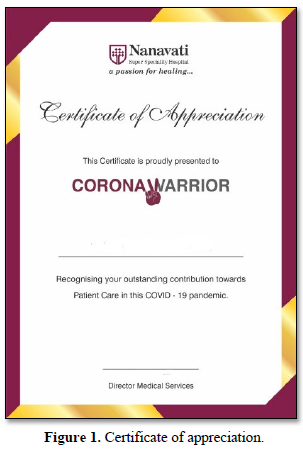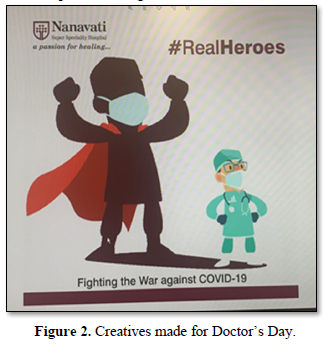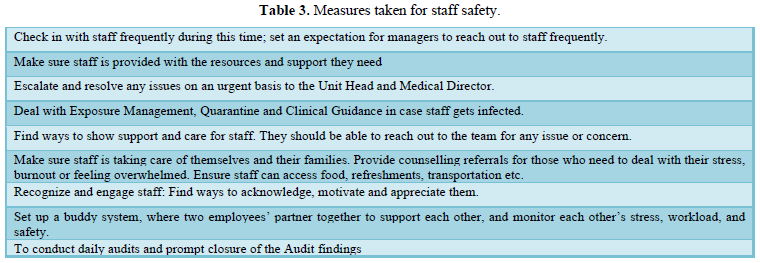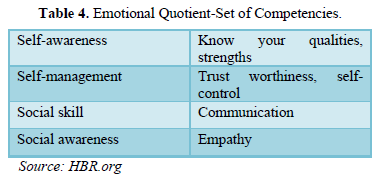Editorial
Teamwork, Morale Building and Empathy-Promoting Mental Well Being an Important Administrative Tool for Good Leadership in This COVID Crisis
3617
Views & Citations2617
Likes & Shares
INTRODUCTION
The COVID-19 pandemic and the lockdown that followed have had a significant impact on businesses and jobs in every sector. Governments and hospitals everywhere have tried to prepare themselves to deal with this global crisis. COVID preparedness has been the priority for health organizations worldwide and new guidelines and protocols are being devised to ensure this. Occupational health is being given prime importance as a safe and healthy work environment is what every healthcare worker needs and deserves for the service they are providing in these difficult times. Various measures like social distancing have been taken to ensure healthcare workers’ (HCW) safety and prevent overburdening of hospitals. The healthcare sector is at the epicenter of this unprecedented challenge, and healthcare workers have risen to the occasion and provided their support in every way possible. The stress of working for days together coupled with the emotional burden of staying away from family has had a toll on every healthcare worker at some point in time. But their determination and dedication towards this noble profession is what helps them to move ahead despite of the hurdles. It is the responsibility of the hospital administrators and managers to make sure that this job is done. Efficient leadership is what this situation needed, and our administration has provided the same diligently. Besides ensuring the safety of staff by providing personal protective devices, hospital administrators had to protect staff morale as well. The entire healthcare staff is risking themselves and their families and without the right motivation and support, the healthcare system will buckle down. Our management realized this need and undertook some special steps to ensure the mental wellbeing of their staff.
We will be discussing the various measures taken at our tertiary care hospital to ensure staff safety, maintain morale and create a healthy work environment.
APEX COMMITTEE
A committee was set up to plan, provide guidance and overlook the progress of the entire process.
The key members of this Apex committee were few of the mentioned in Table 1 but not limited to them.


This is a token of Leaderships mentioned, we owe the credit to all Head of Departments, including (but not limited to) the Chief Nursing Officer & Accreditation coordinator, Quality Manager, Head of Hospital ‘Lab & Hospital Infection Control Officer; including their colleagues, each staff of the hospital who contributed in this pandemic.
The various methods we used to achieve a healthy workplace environment will be discussed under these headings: TEAMS (Table 2).
This pandemic has brought challenges along with it, but our hospital staff has worked together as a team and handled this crisis very efficiently. All the staff has supported each other and motivated each other to do their best with constant support and guidance from the administration.

STAFF SAFETY
Various measures were taken to ensure the safety of all healthcare staff. Screening and social distancing were undertaken at every department in the hospital right from the entry (Figure 3). Visitors (except those with elderly and children) were not allowed so that the disease transmission could be slowed down. All elective investigations and procedures were postponed. Only emergency and semi-emergency patients were managed, to prevent overburdening staff and services. Suspected patients were given a red band so that necessary precautions could be taken while dealing with them. Special training sessions and educational videos

were arranged for staff working in COVID wards and those dealing with patient triage, segregation, and management. Suspected patients were directly sent to special COVID accident and emergency department so that exposure to other staff and patients could be avoided. All healthcare staff was provided the necessary personal protective equipment (PPE) as per guidelines. Those posted in COVID wards were provided rest after a duty of 14 days and food with accommodation by the hospital administration.

were arranged for staff working in COVID wards and those dealing with patient triage, segregation, and management. Suspected patients were directly sent to special COVID accident and emergency department so that exposure to other staff and patients could be avoided. All healthcare staff was provided the necessary personal protective equipment (PPE) as per guidelines. Those posted in COVID wards were provided rest after a duty of 14 days and food with accommodation by the hospital administration.
One of the challenges was dealing with accidental exposure of staff and HCW becoming COVID positive. They were provided support in every way possible, clinical management and psychological (Table 3).
A Staff Health and Safety team was established by the administration.
The team comprised of the following: Headed by

The team comprised of the following: Headed by

Senior Consultant (Director of Critical care/ Intensivist)
- Senior Manager from HR
- Quality Manager
Supported by Consultants, Nursing Coordinators, Managers from Medical Administration.


Objectives imparted to the Staff Health and Staff Safety Team
Prophylaxis: All healthcare personnel were given Hydroxychloroquine prophylaxis by the hospital administration.
Personal protective equipment (PPE): Appropriate PPE was provided to all HCWs and regular training sessions were held for donning/doffing of PPE techniques. Regular/surprise audits and CCTV footage analysis was also done to ensure proper techniques were being adopted. Safety of their staff was the hospitals prime concern every step of the way.
Staff wellbeing: Holistic support was given to all staff by the COVID team supervisors and administrators. All the needs and problems of staff were addressed including financial stability and job security along with safety.
TRAINING, AUDIT, RETRAINING
Training had to be provided for all healthcare staff for their safety including infection control policies, management guidelines and PPE use.
All departments were provided training:
- Consultants, clinical associates, residents, and interns
- Nursing staff-safety,
- Housekeeping staff
- Security personnel
- COVID Screening team-screening and Triage
- Staff safety TEAM.
The adequacy of training was judged by continuous, surprise Audits of Staff Health & Staff safety team and regular feedbacks. Reinforcement training sessions were conducted regularly.
On job training was preferred as it allowed for an interactive session for resolution of queries. Detailed presentations with videos and graphics were made in English & Marathi for better understanding.
INNOVATION
COVID 19 has challenged our workplaces in unprecedented ways, administrators and leaders needed to devise new strategies and build new partnerships to make sure the staff has all the resources required. Our hospital administrators tried to innovate and modify processes already being followed according to new guidelines. New standardized operating procedures were formed by the administration for management of patients during investigations like CT (Computed Tomography) scan and MRI (Magnetic Resonance Imaging) and patients coming in for chemotherapy and hemodialysis. Special corridor was created for patient transfers to imaging departments. Innovating new methods and formulae of computational analysis like duality theorems ensure that computational procedures can be considerably reduced. Duality theorems further yield other powerful theorems. These concepts are used in various aspects of medicine as well for research and development of newer methods of treatment and investigations [4-6].
TEAMWORK
- Cross-departmental Collaboration
Inter-departmental meetings were held with administrative staff daily where representatives from different teams would identify challenges and ways to deal with them. The courage and dedication of our onsite teammates helped inspire everyone across the organization. Teams worked with occupational safety experts to ensure that our supply chains for appropriate personal protective equipment (PPE) and sanitization materials were intact, including building relationships with of PPE. PPE and disinfection material supplies availability has been critical in successfully handling the crisis.
- Buddy system
A buddy system was setup so that people could support each other. The goals of the buddy system were to:
- Get to know each other. Talk about background, interests, hobbies, and family. Identify each other’s strengths and weaknesses.
- Keep an eye on each other. Try to work in the same location if you can.
- Set up times to check-in with each other. Listen carefully and share experiences and feelings. Acknowledge tough situations and recognize accomplishments, even small ones.
- Offer to help with basic needs such as transportation.
- Monitor each other’s workloads. Encourage each other to take breaks.
- Communicate basic needs and challenges to leadership – make your buddy feel “safe” to speak up.
Technological assistance
The administration has actively tried to invest in new technologies like portable CT scanners and artificial intelligence based deep learning software which will add value in the current scenario for patient segregation, management, and treatment. Use of remote access for radiological reporting and teleconsultation for physician consults has helped in reducing burden on doctors as it helps reducing patient contact and thus the risk. Hospitals across the globe have started investing in artificial intelligence (AI) and deep learning technologies. AI has seen a new level of need and acceptance in countries like India where it is still in its new-born phase. Investigations like CT scan and X-ray are making use of AI for identifying and triaging COVID patients in areas without access to diagnostic facilities. Several developments in geometric structure of Banach spaces have found applications in other fields like medicine, economics and natural sciences besides mathematics. New innovations using deep learning technologies and artificial intelligence will require an understanding of concepts like these [7]. New technologies are being devised every day in the medical field. Technologies like artificial intelligence will see a growing trend in the future to come. Understanding these new mathematical programs and solutions will gradually gain importance for doctors as well.
What do hospital administrators need to realize?
Our hospital administration has tried to provide efficient and effective leadership in the most diligent way possible. All the managers and administrators were always available and approachable for any kind of assistance needed by any staff.
Besides qualities like delegation, supervision, conflict management, providing inspiration, a good leader also needs a good balance of emotional intelligence (EI)/emotional quotient (EQ) [8]. To excel, managers need to develop a balance of strengths across the various EI competencies. Qualities like empathy, motivation and teamwork are necessary ingredients for a successful business operation. This holds true for hospitals as well especially in the current scenario. All administrators need to do is ‘Be there’ (Table 4).


POST COVID WORKPLACE
Everything in our workplace has currently changed, but what keeps employees motivated and what employers and leaders can do remains the same, that is to appreciate, encourage and support. This is what the administration believed in and religiously followed.
The changes we have incorporated currently in the way our hospital functions will have to be incorporated in future as well. Sanitization and disinfection management will have to be strictly managed and supervised. New workflows, strategies and SOPS which have been devised may need to be followed for all patients.
Decision making is an integral and indispensable part of life. Every day, one has to make decisions of some type or the other. The decision process is somewhat easier when there is a single criterion or objective in mind. Various multi objective optimization problems are useful mathematical models for the investigation of real-world problems. Multi-objective optimization is an area of multiple criteria decisions making concerned with mathematical optimization problems [9]. On similar lines in the post-COVID era our decisions will have to consider multifaceted aspects like regaining economy, rehabilitation, provision of care to those who had postponed it during the crisis and adjusting to the new normal.
DIGITAL HEALTH
The COVID era has made us realize the importance of digital health. Tele technology is attaining a lot of importance during these difficult times. Use of remote learning, tele-medicine consultations, artificial intelligence and deep learning techniques will have to be encouraged and taught to the newer generation.
CONCLUSION
The COVID pandemic has brought focus on one distinguished human quality, ‘teamwork’. All the HCWs volunteered to give their best, enthusiastically contributed in all ways possible and took, not one but many steps towards a common goal that is to heal and protect. A hospital administrator/managers job is to, ensure their safety, motivate them, and protect them, so that they can do theirs with all the sincerity and dedication. Values like integrity, courage, empathy, and a sense of purpose are the foundations of humanity and it is with these values that our Corona warriors have fought this war.
Leaders have a great responsibility on their shoulders. Appreciation and encouragement are what drives the human psyche. Tremendous efforts have been put by all personnel working towards a common goal and these efforts need to be appreciated.
Patience, calm minds, new administrative ideas and strategies, individual and cumulative discipline, a sense of solidarity and a shared sense of purpose are all that we need currently to overcome these unprecedented and challenging circumstances.
ACKNOWLEDGEMENTS
The authors would like to express their gratitude to all TOP MANAGEMENT of RADIANT Group for their continuous guidance, their continual support and excellent leadership during this crisis and also thank all the key members of the COVID team including the Doctors, Nursing staff , Staff Safety Team , Infection Control Team , Administrative staff, Dietetics, Biomedical Team, Engineering Team, Housekeeping Team , Security , as also each member of the organization who helped in this hospital-wide response to COVID-19.
-
Ministry of health and family welfare (2020) Available online at: https://www.mohfw.gov.in/
-
World Health Organization (2020) Available online at: https://www.who.int
-
Indian Council of Medical Research (2020) Available online at: https://www.icmr.gov.in/
-
Vandana, Dubey R, Deepmala, Mishra LN, Mishra VN (2018) Duality relations for a class of a multiobjective fractional programming problem involving support functions. Am J Oper Res 8: 294-311.
-
Dubey R, Vandana, Mishra VN (2018) Second order multiobjective symmetric programming problem and duality relations under $(F, G_ {f}) $-convexity. Global J Eng Sci Res 5: 187-199.
-
Dubey R, Deepmala, Mishra VN (2020) Higher multiobjective fractional programming problem over cone constraints. Stat Optim Inf Comput 8: 187-205.
-
Mishra VN (2007) Some Problems on Approximations of Functions in Banach Spaces, Ph.D. Thesis, Indian Institute of Technology, Roorkee.
-
Goleman D, Boyatzis RE (2017) Emotional Intelligence Has 12 Elements. Which Do You Need to Work On? Available online at: https://hbr.org/2017/02/emotional-intelligence-has-12-elements-which-do-you-need-to-work-on
-
Dubey R, Vandana, Mishra VN, Karateke S (2020) A class of second order nondifferentiable symmetric duality relations under generalized assumptions. J Math Computer Sci 21: 120-126.
QUICK LINKS
- SUBMIT MANUSCRIPT
- RECOMMEND THE JOURNAL
-
SUBSCRIBE FOR ALERTS
RELATED JOURNALS
- Journal of Neurosurgery Imaging and Techniques (ISSN:2473-1943)
- Journal of Otolaryngology and Neurotology Research(ISSN:2641-6956)
- Advance Research on Alzheimers and Parkinsons Disease
- Journal of Rheumatology Research (ISSN:2641-6999)
- Chemotherapy Research Journal (ISSN:2642-0236)
- Journal of Pathology and Toxicology Research
- Journal of Ageing and Restorative Medicine (ISSN:2637-7403)





